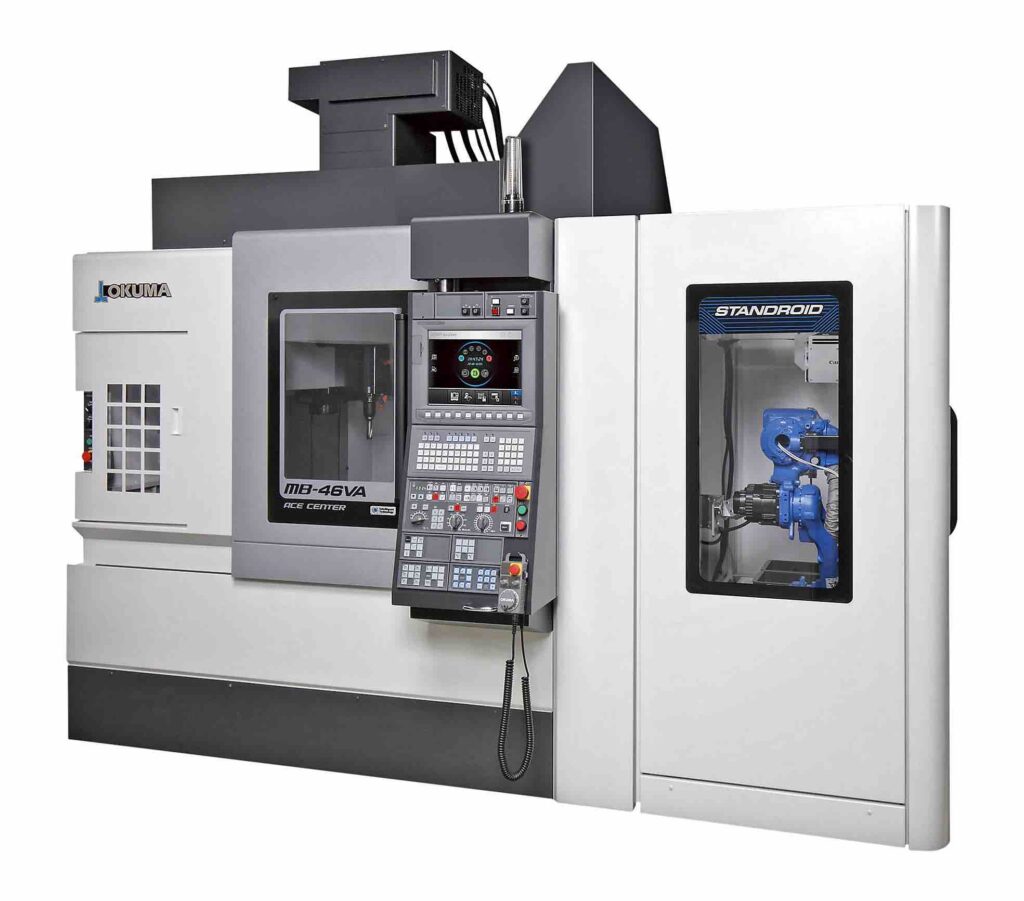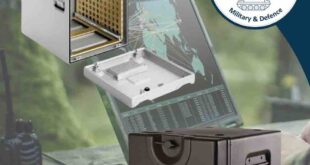Japanese machine tool manufacturer Okuma has incorporated a robotic arm inside its CNC turning centres for automated production of shaft- and chuck-type components. All of the manufacturer’s machine tools are sold and serviced exclusively in the UK and Ireland by sole agent NCMT.
One of the first Okuma lathes to benefit from an internal Armroid (Arm Robot Intelligent Design) workpiece load / unload system is the LB 3000 EX II, one of which is available for demonstration in the agent’s Coventry showroom.
Three different end-of-arm effectors are available for performing different tasks. One is for blasting air or coolant within the cutting zone. It can be programmed to follow the cutting tool for breaking up stringy swarf or to clean down the whole working area, greatly improving chip management. A roller end effector provides support under a shaft component during cutting to minimise chatter.

In combination with a workpiece stacker, the third end effector is a two-finger gripper for automatically holding shaft-type workpieces around their circumference for loading and unloading, weight capacity being 5 kg. All three end effectors are stored within the machine and are exchanged automatically by the robot.
A longer, more powerful Armroid can be integrated into a second Okuma turning centre, a Multus B250II multi-tasking lathe. The robot arm handles workpieces up to 10 kg and possesses a fourth type of end effector with a three-jaw gripper for holding billets around their end faces.
Armroid systems are ideal for high mix, small batch work. The extended periods of unattended running free the operator to carry out duties in other parts of the factory. The cells are not, however, intended for lights-out production of large quantities of the same part due to the limited number of workpieces that can be accommodated by the stocker.
While most conventional robotic systems require complex integration and special training for staff, Armroid needs neither. As the robot is part of the machine tool, expensive system integration is unnecessary. Using Okuma’s own OSP-P300A control, an operator enters the coordinates for the start and finish points and the robot moves through its motions unerringly. Roid Navi software simplifies programming using images and on-screen guides.

As the machine and robot operate seamlessly and always know where each other are, by enabling the control’s built-in collision avoidance system each cycle is automatically generated while avoiding unwanted interference between the moving elements. In addition to automated running under program control, manual operation is possible via a pulse handle that micro-positions the arm.
Machining centre automation
Okuma has also developed a Standroid automation solution with the requirements of small and medium size enterprises in mind. The compact cell, which contains a floor-mounted robot, can be placed next to various Okuma vertical machining centres, either newly purchased or already in production on a shop floor.
Currently, six Okuma machining centres may be equipped with this cell. Simply connecting it to the power supply and a network cable completes the set-up. Whereas conventional robotic systems usually require three days to be integrated, adding a Standroid can be completed in a day and there is no need for safety barriers.
Like Armroid, Standroid is easy to operate by simply defining the start and endpoints of the robot arm, while the system automatically calculates movements and avoids collisions. This greatly reduces set-up and prove-out times. For maximum flexibility, it is possible to switch between automated and manual workpiece loading and unloading.
In conclusion, these automation solutions are designed for OEMs and subcontractors involved in high-mix, low volume production that want to use long periods of unattended operation to deploy personnel elsewhere and maximise operational efficiency. They are not intended for factories producing large volumes of the same component or for lights-out running. When used in suitable applications, the main advantages are a compact footprint, ease of use, minimal operator training, machine-robot compatibility and elimination of the cost and potential difficulties associated with integration by a third party.
 Engineer News Network The ultimate online news and information resource for today’s engineer
Engineer News Network The ultimate online news and information resource for today’s engineer





